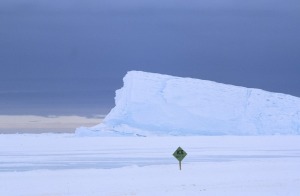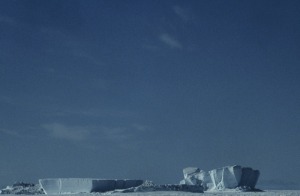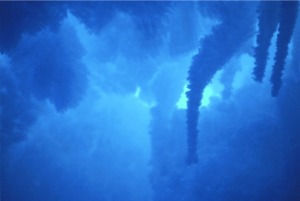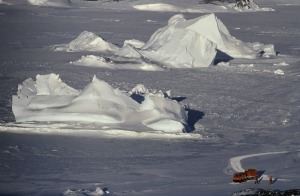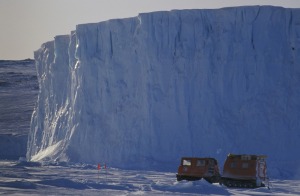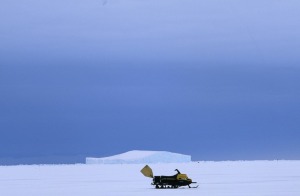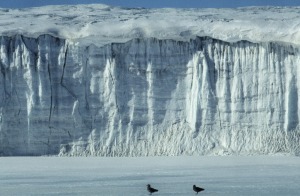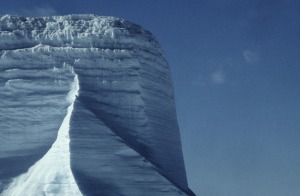2007 :: Issue 1/Fall :: Travel Fragments
Circumnavigating Icebergs
Jason Anthony
When Antarctic ice reaches the sea, it eventually breaks into those recognizable fragments that fend off ships and give form to our dreams of strangeness: icebergs. But whereas each year the Arctic sends down a few monsters to sink Titanics and threaten oil rigs, the Antarctic quietly sends thousands of unseen bergs into the scarcely traveled waters off its shores. And unlike the Arctic, much of what clinks free of the Antarctic ice sheet (an area larger than India and China combined) comes in the form of tabular bergs, mammoth flat-topped chunks of what we call ice shelves. The Ross Ice Shelf, for example, which touches on the island I called home for eight austral summers while working in the United States Antarctic Program, released a tabular berg several years ago roughly the size of Connecticut.
In my years of Antarctic work and meditation, my reading of Antarctic history, my circling, I’ve noticed something about how we see icebergs. We pretend that they exist only as objects in their current state, but icebergs are only the final pieces—like the dry scattered bones of mammals—of a complex irreducible millennial evolution. A few small dry flakes fall somewhere near the South Pole, then enter the ocean as transfigured ice crystals a hundred centuries later. The picturesque bergs that bob and dissolve have spent countless years as anonymous parts of a continental whole that astonishes every human eye that sees it. Icebergs have an untranslatable story, a history, that has captivated me for much of my adult life. I circle them to imagine that story.
:: :: ::
Jan. 1, 1739: Jean-Baptiste Charles Bouvet de Lozier commands a ship that skitters toward an unknown island in the high southern latitudes, after weeks of terrified and hypothermic sailing among icebergs. He cannot approach nor circumnavigate the isle, yet soon runs away north with the false assumption that it is a peninsula of the long-theorized Terra Australis Incognita. His nervous discovery would be the first crack in the millennial hermetic seal of all things Antarctic, albeit little better than a young child stumbling onto a clue that will lead others to the real mystery within.
::
Icebergs are mere crumbs fallen from the continent’s tablecloth.
::
[Feb. 24, 1898:] When you have sailed among the ice for a while you know that the swell never penetrates deep into the ice. I deduce that there is probably no land near the ship because in that case there would be many more and much larger icebergs to be seen. Today I counted 75 across the entire horizon.
—Roald Amundsen, Belgica Diary
::
Flying to the Antarctic for the first time, I assuaged the monotony of several cramped hours over the Southern Ocean with wonder and excitement. I just might reach the New World. After reaching cruising altitude, we unbelted and stretched out on the military cargo, read, slept, or peeked out the few small porthole windows.
For the first few hours the ocean and clouds looked familiar, until with no fanfare but the suddenly perceptible eye contact passing around the plane, ice was seen below us. We’d crossed the Antarctic Convergence, a meeting of oceanic currents which keeps most of the warm air and water to the north, and most of the cold air and ice to the south. Far beneath our propeller-driven Mayflower lay bits of sea ice and an occasional iceberg, messengers sent out from the continent some hours ahead.
No longer able to sleep, I spent as much time at the windows as is polite, and a little more. I was one of only a few new arrivals in our group. I stared and stared out to an icier and icier planet. From the scattered pieces of the sea ice and bergs we moved to whole sheets of pack-ice, interspersed with leads of open water. After a while the white sheet was whole, was all, and the cloud shadows played equally on it and with the eye, making topography where none exists. Then, scarcely perceptible and even more scarcely believable, ice-drowned land rose out of the doldrums of the frozen sea.
::
Icebergs slough off in megatons what was gathered in milligrams.
::
Majestic tabular bergs whose crevices exhaled a vaporous azure; lofty spires, radiant turrets and splendid castles; honeycombed masses illumined by pale green light within whose fairy labyrinths the water washed and gurgled. Seals and penguins on magic gondolas were the silent denizens of this dreamy Venice.
—Frank Wild, in Home of The Blizzard
The men of the Heroic Age of Antarctic exploration transformed these ready-made sculptures with their wishful metaphors, clinging to the Antarctic happenstance that resembled their suddenly irrelevant northern imagination. These ornaments fallen from the great wall of the empire of ice are the only parts of the continent that still looked like objects in their world. For Frank Wild (and the others), Romantic notions from feudal Europe fed their new romance with these cold sentries of the unoccupied ice.
Once the explorers moved inland over the flat abstract ice terrain, nothing in Europe, or anywhere else they’d ever been, told them how to respond to that which they thought they were conquering. Icebergs have a complexity and grace that has almost nothing to do with the monotonous heart of the Antarctic.
Such dreamy phrases have never been sung about the Antarctic interior, nor have fairies or penguins ever been its denizens. At the icebergs’ source, the mile-deep ice caps that shroud the continent and flow over glacial millennia to the watery kingdom of the Southern Ocean, there are no songs, nor squawks.
::
The annual volume of icebergs released from the Arctic is generally measured in cubic meters, while the volume of bergs breaking free from Antarctica is measured in cubic kilometers.
::
—one felt that one was underground, looking at water, at enchantments, with the soul of a chrysalis.
—Henri Michaux, in Darkness Moves
We entered the ice from the side, into the exposed end of a crevasse, from the surface of the frozen ocean. We found inside, away from direct sunlight and wind, a world of linked rooms within breathing ice. I slid 20 feet down into the first chamber from the drifted snow outside, then shimmied through a long curving sheer-walled passageway until a tumble through a waist-high hole brought me humbled into the central chamber.
In there, an absolute blue flooded my senses, as if I had crawled into a blue neon tube bent in the shape of a wave. The Antarctic sun shone down through a thick lid of snow, so that all colors but a blue within blue were filtered out. Layers of large crystals, the rhythmic and fragile tools with which ice reaches out into perfectly still air, lined the roof and walls. The chamber looked like a nursery for chandeliers. Up to several inches across, crystals tinkled onto the muffled floor whenever our parka shoulders brushed against them.
No other sound but what we made could be heard, and what was left when I stood still, in the few moments I had alone, was the polyrhythm made by my breath, tinnitus, and the beating of an amazed heart.
::
Nothing I can say will enter that iceberg, penetrate that block of silence. No words I speak to my feet will sink through the icecap. Nothing I exhale has warmth enough to make durable clouds.
Do flurries form from my breath? Does Antarctica groan under my weight? Did I startle the crevasse?
Each warm gesture I make against this cold is one tenth momentum, nine tenths inertia.
::
Went on a walk across the sea ice near Marble Point, this time in the Bay of Sails, a bay hemmed in by the immense sheer-walled Wilson Piedmont Glacier. A field of orphaned giants, scattered like houses after a flood, marks this coast. I chose one to slowly circle.
It is a behemoth of no-thought. Yet its complex half-melted form, its metaphorical imprisonment, and its proximity to the ocean somehow give the berg an aspect of life. This thing I choose to approach and be marked by, isn’t it a cold idea released from the nearby forehead?
It hasn’t traveled far, and only into waters that take and absorb it as this air takes my heat.
::
Icebergs, without guardrail, without girdle, where old weather-beaten cormorants and the souls of recently dead sailors lean on their elbows on the enchanting and hyperboreal nights.
Icebergs, Icebergs, cathedrals without religion of the eternal winter, robed in the glacial skullcap of the planet Earth.
How high, how pure are your edges, born of the cold.
Icebergs, Icebergs, back of the North Atlantic, august Buddhas frozen on uncontemplated seas, gleaming Lighthouses of Death without issue, the desperate cry of the silence lasts for centuries.
Icebergs, Icebergs, Solitaries without cause, countries barred-up, distant and free of vermin. Parents of islands, parents of springs, how well I see you, how familiar you are to me—
—Henri Michaux, from “Icebergs”
Though born up north, Michaux’s icebergs and poetry are sufficient for the faithless cathedrals down here. Moreover, our tabular bergs that are unknown in the Arctic more aptly fit the description of hidden countries, since some that dislodge from the ice shelves are larger than several European nations. And I love the idea of his “Lighthouses of Death”: these lighthouses set forth from the coast through the paths of ships, defending the coast rather than giving warning of it.
::
Sir Robert Scott, Edward Wilson, and Birdie Bowers are about 25 meters down in the Ross Ice Shelf, encased in their tent together, and heading for Cape Crozier. Assuming no acceleration due to global warming, their bodies should calve off the Barrier in about 250 years, late in the summer, three smears and some canvas coloring an iceberg headed for dissolution somewhere within the Southern Ocean.
Cape Crozier is where Wilson and Bowers, with Apsely Cherry-Garrard, cheated death on the Winter Journey in 1911. Their return will be under conditions only slightly more brutal.
Dying’s the best
Of all the arts men learn in a dead place.””James Wright, from “At the Executed Murderer’s Grave”
::
Thirteen miles up the coast from McMurdo, standing on the shore at Cape Evans, Ross Island, where Robert Scott’s 1910 Terra Nova expedition hut sits like an abandoned bunker against the cold, I saw a far-off flock of small snow-white birds wheeling together near the bluer-than-sky ice cliffs of the Barne Glacier. Snow petrels flash like distant windows when turning under this hard light, like some living transition between crystal and cell. These birds in flight were better mirrors for the intense Antarctic sunlight than the ice. They leveled out and fluttered whitely north toward icebergs and open water while we stepped over the remains of crates, tools, and dogs.
Half-buried on the shore is an anchor from the Aurora, a ship full of vital supplies ripped from its chains by a 1915 winter storm. The ship drifted with the shifting pack ice and bergs and wasn’t seen again by the expedition for a year. The abandoned men scavenged from Scott’s garbage dumps as they readied themselves to enter the dark chambers of Antarctic history.
Like an iceberg, the hut is a monument to both grace and disintegration. Both the Terra Nova and Aurora expeditions came to this shore with strong men and high hopes, and both left bodies and unrealized dreams on the ice shelf when they sailed away. The wind-scoured planks on the hut’s exterior were radiant in the thick Antarctic sunshine, while inside, men’s bunks and horses’ stalls felt emptier than the landscape. Gray wool blankets and an 80-year-old bicycle, a black cook stove and a darkroom: all of it is a cemetery and an echo of the fate of all warm bodies thrown too hard against the ice.
::
Standing quietly in the middle of the bight where we await the icebreaker, we find the Antarctic silence broken now by the slight jostling of the sea ice. We’re laying a half mile of hose from the shore across the ice. The icebreaker will plow through the sea ice up to the end of the hose, plug in, and pump fuel for a day and a half.
Beside us as we set up, though, are a few small bergs, fast in the sea ice, waiting for release. We bend and extend the hose to an open area. At the end of a long workday, we walk around one, admiring the random proportions of an impregnable vault of ice ephemeral enough to one day melt into the ocean but massive enough to fend off ships.
::
Come December, rare groups of visitors to McMurdo Station arrive in small flocks from their expensive cruise vessels. In tight clumps, they follow their expedition leaders from the helicopter to the cafeteria, where they buy trinkets and are given an antiseptic tour of our industrial base. Before leaving, they have their pictures taken, with parka hoods up, on December’s warm +30° F days while icebergs jostle for space in the background. Meanwhile, outside the frame, McMurdo residents walk by in shorts, t-shirt, sneakers, and a fleece cap on their way to the gym.
::
Just as now we congratulate ourselves for frontier living while in the bar or hiking up Observation Hill, someday a tourist will gaze out from his hotel at the South Pole with wistful eyes, and an oil roughneck will be mesmerized into self-importance by the icebergs sailing around her platform.
::
Antarctic fragility is a valid concept if you think of the continent merely in terms of the spotty penguin-dotted coastline and the surrounding Southern Ocean. And in fact, this is how the ice is advertised and romanticized up north: “The penguin and iceberg crowd,” as my friend Nicholas Johnson calls them, keep the cameras trained on the charismatic and truly fragile coast, while the exquisitely monotonous landscape of the ice caps (some 90% of the continent—) is lost in the collective wowing. The Antarctic interior is so strange and so unknown that its distant audience naturally grasps at coastal symbols, whether cute (penguins) or majestic (icebergs).
::
Another windless day at Marble Point, and so another wander around the Bay of Sails. Found myself drawn to the sheer walls of an iceberg now lightly channeled with meltwater. Day after day of strong sunlight are just enough to bring faint streams down the berg, but only when the light is direct. At the moment the sun hides behind a cloud, the melting stops.
The cobalt blue radiating from those 100 foot walls under the noonday sun saturated my eyes. The air seemed to ache around the erratic gentle dripping that was the only sound for miles. These bergs, the “sails” in the bay (white-blue from a distance, a quiet fleet), sit luffed above the ocean-wide raft they’re supposed to empower.
I’ve enjoyed these solitaires since my first visits to Marble Point in 1995, and have each time fallen in love with their monolithic island-ness. The tenuous solidity of both berg and sea ice awes me, makes me feel like an irrelevant mote.
Other motes, the skuas, bathed in the blue-green melt pools at the base of the berg. Their tracks in the surrounding snow were the perfect sketch of purpose: a two-footed landing, some slowing jumps, and then a few cautious steps to the pool. The splashes were unrecorded, but then steps coming out reversed the arrival, adding feather marks where the wings stroked the snow in their surge to gain height.
A few seals rested next to a jagged crack that ran from the berg to the shore, and their thick slug-trails in the snow looked like tethers to the dark biology beneath us. My own tracks had the mark of less purpose, unnecessary peninsulas of steps taken to investigate each thing and then backing away. Mainly they indicated a minor affair with the iceberg, a free, even nonchalant, circumnavigation around this strange vessel, while I watched death melt slowly into life.
::
Off on a Coast Guard icebreaker “morale cruise.” Each year, once the ship has cleared a path through the sea ice for the tanker and cargo vessels, the captain may offer to take large groups of McMurdo employees for short trips out of town. I’ve been on the boat a few times over the years, mostly for fuel delivery to Marble Point, but each voyage out of town is beautiful, and each voyage is a relief.
The pleasure of being out in the bitter wind, away from work, and forcing our way through this crust, comes mainly from the feeling of escape. McMurdo has kept me for much of the season, and a boat ride is the perfect antidote to claustrophobia. I’m thinking, too, about not coming back to our version of Antarctica again. This little trip reminds me that right now leaving is feeling more important than coming back.
We slashed a dark line through the shipping channel, now filled with brash ice dotted with penguins and seals. Floes the size of buses peeled off the bow like newspaper before a wind. Penguins scattered away from the ship, porpoising between the floes and catapulting onto the solid ice. Seals struggled to wedge between jostling ice chunks as the unfamiliar bow loomed. Not one of the hundreds of penguins or seals we saw was calm or still, yet the crowd photographed their terror and called it cute.
(It’s the same back home: we take note of animals as they flee or sound an alarm at our presence. We assume the disturbance is natural.)
Someone in the crowd lining the bow murmured about the icebergs several miles ahead, as if they posed some threat. What we forget, I suppose, is that bergs are not dangerous to any other species but us.
Out in open water, as the ship took a brief spin around a berg before heading back to town, I realized I might be staring at one that I had walked around in the Bay Of Sails. This was its dissolution, the end of the berg’s life begun millennia ago as an assortment of snowflakes somewhere higher up in the Transantarctic Mountains, a giving back to the ocean what the atmosphere borrowed in an earlier eon.
Many endings and beginnings scattering out of them like waves.
::
This Antarctic prose of mine, and my other verbal debris, sit unattached, detached, like snow that does not want to be glacier. By my intuition, and by my definition, these responses to Antarctic landscape, history and experience must be recorded in fragments. “Icebergs,” perhaps, but the writing is better served by a metaphor of experience than of image. Iceberg as process, not object: a few crystalline words convened tightly, moving irregularly, within the aqueous world of memory and purpose, semitranslucent matter in transit, aspiring to be perfectly broken language.
::
Feb. 18, 1912: Wilhelm Filchner, German explorer, was establishing a winterover camp on the edge of the Weddell Ice Shelf, but suddenly found his operation adrift as the ice beneath them calved off. The men rejoined their ship after frantically disassembling their house and reloading their cargo, but left behind one dog, who refused to be caught. Filchner then sailed away.
A stubborn animal floating north on a tabular berg, adrift, no doubt hunting along the edges in the days before he starved: just one more Antarctic expedition we’ll never understand.
